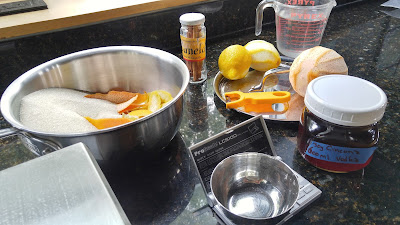A friend mentioned having "octopus terrine" which I'd never heard of, but then recalled a chef's table meal at Galileo where we watched one of the cooks slicing something about the size of a mortadella but was clearly comprised of octopus tentacles.
Most preps I found simply cooked the octopus then tightly pressed the legs together in a mold while still quite warm, where the internal gel would set them overnight.
The version I'm doing here is based on a British site where they use gelatin combined with the juices exuded by the octopus to bind everything together. I had only small, hand-sized octopi and didn't want to waste the tasty liquid, so I cooked the beasts sous vide to capture the rendered liquid in the bag.
I wasn't very careful about this prep but would like to repeat it, perhaps without the gelatin, saving the juice for another dish like risotto.
1 pound Octopus, cleaned and thawed
Pimenton
Salt
Meyer Lemon Zest
1 envelope Knox Gelatin
Add the whole cleaned octopus to a sous vide bag. Add some Pimenton, Salt, and Meyer Lemon Zest. Seal and cook 5 hours at 77C. The octopus will shrink quite a bit and release a lot of liquid -- I figure we usually lose 1/2 to 2/3rd the weight of the octo to the liquid.
Strain a small portion of the octopus liquid into a bowl and set in another bowl of ice water: we need to cool it to prevent Gelatin from clumping. Add Gelatin powder to the cooled liquid, and let hydrate 5 minutes. Add the rest of the strained juice while still hot and stir well to combine.
With cling film, line a mold, ideally just big enough to contain the octo and liquid. Cut the tentacles from the octo, and slice the head. Add all the bits to the lined mold, then add the gelatin liquid.
Wrap the film around as snugly as you can, which won't be much as the gel is still liquid at this point. Weight the top to press firmly and chill overnight in the fridge. We used little cutlery trays for kitchen drawers: they were about the right size and stacked neatly for the weights.
The next day, remove from fridge, unwrap carefully and tip out to a serving plate. To serve, heat a very sharp knife in hot water, and slice cleanly.
What Worked, What Didn't
I didn't rinse the octopi when I removed them from the sous vide bag, so the gel was muddied by the spices left on the beasties.
There's too much aspic, I think I'd prefer doing it without the gelatin, just saving the liquid for another use.
There's too much aspic, I think I'd prefer doing it without the gelatin, just saving the liquid for another use.
Cooking sous vide allows me to dial in the time/temperature I want, and captures all the tasty octopus juice, even if I don't use it in this preparation.
Seasoning was good -- just salt and pimenton -- but I didn't record what I used.
Seasoning was good -- just salt and pimenton -- but I didn't record what I used.
Next Time
Rinse the cooked octopi in hot water so the gel will be clear.
Use larger octopi with big legs. Use about twice as much to fully fill the mold.
If not using gelatin, we may need four times as much for the same size. Some recipes sans gel here, here, along with Chef Steps suggestions for sous vide time and temp.

















































